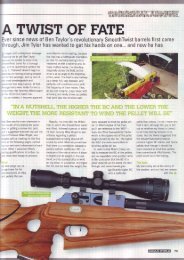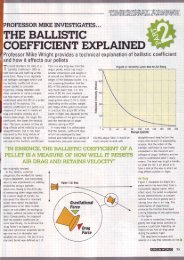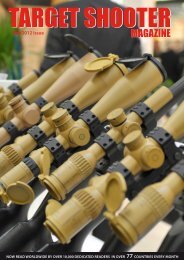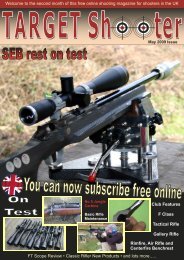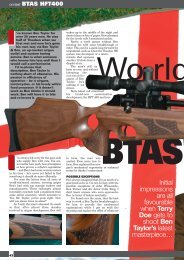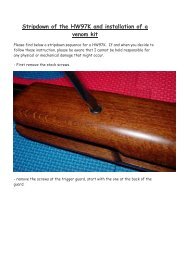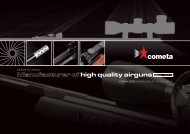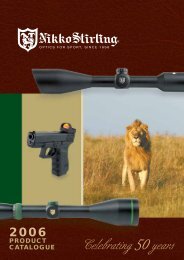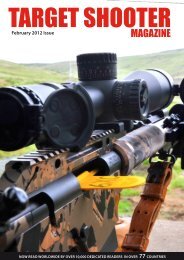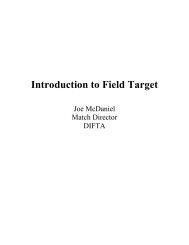Target Shooter 1
Target Shooter 1
Target Shooter 1
You also want an ePaper? Increase the reach of your titles
YUMPU automatically turns print PDFs into web optimized ePapers that Google loves.
A reproduction bracket<br />
and they are now ready. They are made to tight<br />
tolerances to ensure that they collimate within<br />
acceptable limits when fitted to genuine rifles.<br />
Experience and minor tweaks have made each<br />
successive batch better and the quality is so high<br />
that, to quote the noted authority on the subject,<br />
Peter Laidler, when answering a question on<br />
one of the internet collector forums “…about 50<br />
or so of Roger Payne’s brackets were utilised on<br />
the latter rebuilds of the L42’s destined for War<br />
Reserve stocks and they were indeed<br />
perfect. It’s ironic that some of the L42 owners<br />
out there who would probably shudder at a repro<br />
anything, probably have an MoD fitted repro<br />
bracket. Does that make it a repro? The owners<br />
of those rifles can at least be assured that they<br />
have one of the dedicated War Reserve Stocks<br />
held at xxxxxxxx in Berkshire. The steel stock<br />
and quality assessment was done at the material<br />
labs at Shrivenham and even that was the same<br />
horrible black-heart (or was it white-heart...?)<br />
malleable cast! It’s such an old formula that I can’t<br />
find the mix in Machinery’s handbook any more!”<br />
They are difficult to distinguish from an original<br />
Dalglish made bracket and have helped pair up a<br />
scope with a suitable rifle which would otherwise<br />
have continued to gather dust in a corner. The<br />
value of a complete rifle, even if the rifle and scope<br />
are mismatched, is far greater than the sum of<br />
its parts so the brackets are a great investment.<br />
Scope Tins and Canvas Cases<br />
There were two types of tin or Case Sighting<br />
Telescope No.8. The early ones had<br />
rounded corners, which were quite<br />
expensive to make, so a simpler square<br />
cornered version was made. Manufacturers were<br />
Belling & Co of Enfield, marked B&Co and Berrys<br />
Electrical Company, marked B.E.Ltd. The<br />
Canadians also made rounded cornered tins<br />
plus the canvas case. In November 1944<br />
the Case Sighting Telescope No.8 Mk2 was<br />
introduced. This canvas case was initially<br />
made by Mills Equipment Co. but there were<br />
five other manufacturers – they are quite scarce<br />
today. During the refurbishment of No.4(T)’s<br />
in the 1950’s more of the rounded corner tins<br />
were made by S.G.C. and could be dated 1954,<br />
1955 or 1956. During the conversions to the<br />
L42A1 sniper rifle in the 1970’s and 1980’s more<br />
rounded tins were produced by Pressed Steel<br />
Metal Work Co, marked PSMW and dated 1973 or<br />
Cooke & Perkins, marked C&P and dated 1983.<br />
Chest, Small-Arms, No.15 Mk1 Introduced in<br />
February 1942 the basic design was copied from<br />
the Bren Gun chest but with repositioned leather<br />
handles on the sides and new fixing blocks to<br />
hold the rifle and the scope tin plus the Scout<br />
Reg. spotting scope. These chests are now very<br />
scarce.<br />
Leather Slings and Lens Caps<br />
The American 1903A1 Springfield Rifle two part<br />
<strong>Target</strong> <strong>Shooter</strong> 37



